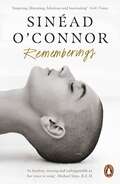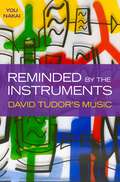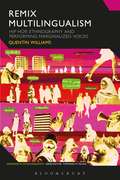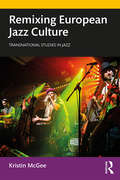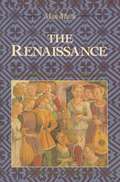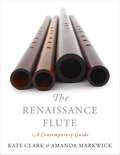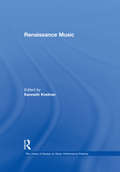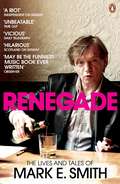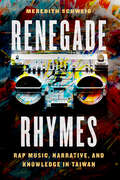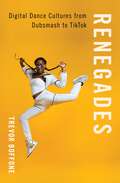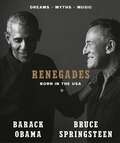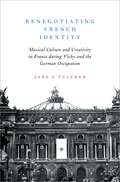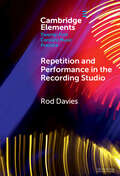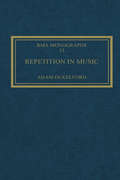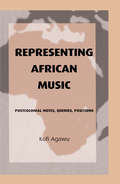- Table View
- List View
Rememberings
by Sinéad O'ConnorTHE LANDMARK MEMOIR OF A GLOBAL MUSIC ICONSinéad O'Connor's voice and trademark shaved head made her famous by the age of twenty-one. Her recording of Prince's Nothing Compares 2 U made her a global icon. She outraged millions when she tore up a photograph of Pope John Paul II on American television.O'Connor was unapologetic and impossible to ignore, calling out hypocrisy wherever she saw it.She has remained that way for three decades.Now, in Rememberings, O'Connor tells her story - the heartache of growing up in a family falling apart; her early forays into the Dublin music scene; her adventures and misadventures in the world of sex, drugs and rock'n'roll; the fulfilment of being a mother; her ongoing spiritual quest - and through it all, her abiding passion for music.Rememberings is intimate, replete with candid anecdotes and full of hard-won insights. It is a unique and remarkable chronicle by a unique and remarkable artist.'Inspiring, liberating, hilarious and fascinating' Irish Times'Beautifully observed ... lyrical, funny and anguished' Guardian'So good, you'll want to read it twice' Sunday Independent'A soul-bearing, brutally honest account of an extraordinary life' BBC Online'Devastating, wise, hilarious and original' Róisín Ingle
Reminded by the Instruments: David Tudor's Music
by You NakaiDavid Tudor is remembered today in two guises: as an extraordinary pianist of post-war avant-garde music who worked closely with composers like John Cage and Karlheinz Stockhausen and as a founding figure of live-electronic music. His early realization of indeterminate graphic scores and his later performances using homemade modular instruments both inspired a whole generation of musicians. But his reticence, his unorthodox approaches, and the diversity of his creative output which began with the organ and ended with visual art have kept Tudor a puzzle. Illustrated with more than 300 images of diagrams, schematics, and photographs of Tudor's instruments, Reminded by the Instruments sets out to solve the puzzle of David Tudor by applying Tudor's own methods for approaching the materials of others to the vast archive of materials that he himself left behind. You Nakai deftly patches together instruments, electronic circuits, sketches, diagrams, recordings, letters, receipts, customs declaration forms, and testimonies like modular pieces of a giant puzzle to reveal the long-hidden nature of Tudor's creative process. Rejecting the established narrative of Tudor as a performer-turned-composer, this book presents a lively portrait of an artist whose activity always merged both of these roles. In reading Tudor's electronic devices as musicological 'texts' and examining his idiosyncratic use of electronic circuits, Nakai undermines discourses on sound and illuminates our understanding of the instruments behind the sounds in post-war experimental music.
Reminded by the Instruments: David Tudor's Music
by You NakaiDavid Tudor is remembered today in two guises: as an extraordinary pianist of post-war avant-garde music who worked closely with composers like John Cage and Karlheinz Stockhausen and as a founding figure of live-electronic music. His early realization of indeterminate graphic scores and his later performances using homemade modular instruments both inspired a whole generation of musicians. But his reticence, his unorthodox approaches, and the diversity of his creative output which began with the organ and ended with visual art have kept Tudor a puzzle. Illustrated with more than 300 images of diagrams, schematics, and photographs of Tudor's instruments, Reminded by the Instruments sets out to solve the puzzle of David Tudor by applying Tudor's own methods for approaching the materials of others to the vast archive of materials that he himself left behind. You Nakai deftly patches together instruments, electronic circuits, sketches, diagrams, recordings, letters, receipts, customs declaration forms, and testimonies like modular pieces of a giant puzzle to reveal the long-hidden nature of Tudor's creative process. Rejecting the established narrative of Tudor as a performer-turned-composer, this book presents a lively portrait of an artist whose activity always merged both of these roles. In reading Tudor's electronic devices as musicological 'texts' and examining his idiosyncratic use of electronic circuits, Nakai undermines discourses on sound and illuminates our understanding of the instruments behind the sounds in post-war experimental music.
Remix Multilingualism: Hip Hop, Ethnography and Performing Marginalized Voices (Advances in Sociolinguistics)
by Quentin Williams"Remixing multilingualism" is conceptualised in this book as engaging in the linguistic act of using, combining and manipulating multilingual forms. It is about creating new ways of 'doing' multilingualism through cultural acts and identities and involving a process that invokes bricolage. This book is an ethnographic study of multilingual remixing achieved by highly multilingual participants in the local hip hop culture of Cape Town. In globalised societies today previously marginalized speakers are carving out new and innovating spaces to put on display their voices and identities through the creative use of multilingualism.This book contributes to the development of new conceptual insights and theoretical developments on multilingualism in the global South by applying the notions of stylization, performance, performativity, entextualisation and enregisterment. This takes place through interviews, performance analysis and interactional analysis, showing how young multilingual speakers stage different personae, styles, registers and language varieties.
Remix Multilingualism: Hip Hop, Ethnography and Performing Marginalized Voices (Advances in Sociolinguistics)
by Quentin Williams"Remixing multilingualism" is conceptualised in this book as engaging in the linguistic act of using, combining and manipulating multilingual forms. It is about creating new ways of 'doing' multilingualism through cultural acts and identities and involving a process that invokes bricolage. This book is an ethnographic study of multilingual remixing achieved by highly multilingual participants in the local hip hop culture of Cape Town. In globalised societies today previously marginalized speakers are carving out new and innovating spaces to put on display their voices and identities through the creative use of multilingualism.This book contributes to the development of new conceptual insights and theoretical developments on multilingualism in the global South by applying the notions of stylization, performance, performativity, entextualisation and enregisterment. This takes place through interviews, performance analysis and interactional analysis, showing how young multilingual speakers stage different personae, styles, registers and language varieties.
Remixing European Jazz Culture
by Kristin McGeeRemixing European Jazz Culture examines a jazz culture that emerged in the 1990s in cosmopolitan cities like Amsterdam, Rotterdam, Berlin, London, and Oslo – energised by the introduction of studio technologies into the live performance space, which has since developed into internationally recognised, eclectic, hybrid jazz styles. This book explores these oft-overlooked musicians and their forms that have nonetheless expanded the plane of jazz’s continued prosperity, popularity, and revitalisation in the twenty-first century – one where remix is no longer the sole domain of studio producers. Seeking to update the orthodoxies of the field of jazz studies, Remixing European Jazz Culture: incorporates electronic and digital performance, recording, and distribution practices that have transformed the culture since the 1980s; provides a more diverse and multifaceted cultural representation of European jazz and the contributions of a variety of performers; and offers an encompassing picture of the depth of jazz practice that has erupted through Northern Europe since 1989. With an expansion of international networks and a disintegration of artistic boundaries, the collaborative, performative, and real-time improvisational process of remixing has stimulated a merging of the music’s past and present within European jazz culture.
Remixing European Jazz Culture
by Kristin McGeeRemixing European Jazz Culture examines a jazz culture that emerged in the 1990s in cosmopolitan cities like Amsterdam, Rotterdam, Berlin, London, and Oslo – energised by the introduction of studio technologies into the live performance space, which has since developed into internationally recognised, eclectic, hybrid jazz styles. This book explores these oft-overlooked musicians and their forms that have nonetheless expanded the plane of jazz’s continued prosperity, popularity, and revitalisation in the twenty-first century – one where remix is no longer the sole domain of studio producers. Seeking to update the orthodoxies of the field of jazz studies, Remixing European Jazz Culture: incorporates electronic and digital performance, recording, and distribution practices that have transformed the culture since the 1980s; provides a more diverse and multifaceted cultural representation of European jazz and the contributions of a variety of performers; and offers an encompassing picture of the depth of jazz practice that has erupted through Northern Europe since 1989. With an expansion of international networks and a disintegration of artistic boundaries, the collaborative, performative, and real-time improvisational process of remixing has stimulated a merging of the music’s past and present within European jazz culture.
The Renaissance: From the 1470s to the end of the 16th century (Man And Music Ser.)
by Iain FenlonFrom the series examining the development of music in specific places during particular times, this book looks at European countries at the time of the Renaissance, concentrating on Italy. It is to be published in conjunction with a television series.
The Renaissance Flute: A Contemporary Guide
by Kate Clark Amanda MarkwickThe renaissance flute, with its rich history, stunning repertoire, and mellow tone, has attracted a significant following among flutists, whether they specialize in modern flute or historical instruments. Yet, actually delving into the study of renaissance flute has proven a challenge - there exists a confusing array of editions of renaissance music, specialized (and often expensive) facsimiles of manuscripts and early prints, and in unfamiliar notations, while at the same time there is a dearth of resources for beginners. Confronting this challenge with the first ever practitioners' handbook for renaissance flute, Kate Clark and Amanda Markwick offer flutists of all levels a clear and accessible introduction to the world and repertoire of the instrument. In The Renaissance Flute: A Contemporary Guide, Clark and Markwick cover all aspects, from practicalities such as buying and maintaining the instrument, to actual music for solo and group performance, to theory designed to improve the understanding and playing of renaissance polyphony. This approach enables students to immerse themselves at their own pace and build on their skills with each chapter. With nearly 40 full pages of exercises, and a companion website with recorded examples and filmed instructions from the authors, The Renaissance Flute provides professionals and newcomers alike a new entryway into the world and practice of renaissance music.
The Renaissance Flute: A Contemporary Guide
by Kate Clark Amanda MarkwickThe renaissance flute, with its rich history, stunning repertoire, and mellow tone, has attracted a significant following among flutists, whether they specialize in modern flute or historical instruments. Yet, actually delving into the study of renaissance flute has proven a challenge - there exists a confusing array of editions of renaissance music, specialized (and often expensive) facsimiles of manuscripts and early prints, and in unfamiliar notations, while at the same time there is a dearth of resources for beginners. Confronting this challenge with the first ever practitioners' handbook for renaissance flute, Kate Clark and Amanda Markwick offer flutists of all levels a clear and accessible introduction to the world and repertoire of the instrument. In The Renaissance Flute: A Contemporary Guide, Clark and Markwick cover all aspects, from practicalities such as buying and maintaining the instrument, to actual music for solo and group performance, to theory designed to improve the understanding and playing of renaissance polyphony. This approach enables students to immerse themselves at their own pace and build on their skills with each chapter. With nearly 40 full pages of exercises, and a companion website with recorded examples and filmed instructions from the authors, The Renaissance Flute provides professionals and newcomers alike a new entryway into the world and practice of renaissance music.
Renaissance Music
by Kenneth KreitnerWe know what, say, a Josquin mass looks like but what did it sound like? This is a much more complex and difficult question than it may seem. Kenneth Kreitner has assembled twenty articles, published between 1946 and 2009, by scholars exploring the performance of music from the fifteenth and sixteenth centuries. The collection includes works by David Fallows, Howard Mayer Brown, Christopher Page, Margaret Bent, and others covering the voices-and-instruments debate of the 1980s, the performance of sixteenth-century sacred and secular music, the role of instrumental ensembles, and problems of pitch standards and musica ficta. Together the papers form not just a comprehensive introduction to the issues of renaissance performance practice, but a compendium of clear thinking and elegant writing about a perpetually intriguing period of music history.
Renaissance Music
by Kenneth KreitnerWe know what, say, a Josquin mass looks like but what did it sound like? This is a much more complex and difficult question than it may seem. Kenneth Kreitner has assembled twenty articles, published between 1946 and 2009, by scholars exploring the performance of music from the fifteenth and sixteenth centuries. The collection includes works by David Fallows, Howard Mayer Brown, Christopher Page, Margaret Bent, and others covering the voices-and-instruments debate of the 1980s, the performance of sixteenth-century sacred and secular music, the role of instrumental ensembles, and problems of pitch standards and musica ficta. Together the papers form not just a comprehensive introduction to the issues of renaissance performance practice, but a compendium of clear thinking and elegant writing about a perpetually intriguing period of music history.
Renegade: The Lives and Tales of Mark E. Smith
by Mark E. SmithStill going after thirty years, The Fall are one of the most distinctive British bands, their music - odd,spare, cranky and repetitious - an acknowledged influence on The Smiths, The Happy Mondays, Nirvana and Franz Ferdinand. And Mark E. Smith IS The Fall - 47 members have come and gone over the years yet he remains its charismatic leader, a professional outsider and all-round enemy of compromise, a true enigma. There have been a number of biographies of the legendary Smith, but this is the first time he has opened up in a full autobiography. For the first time we get to hear his full, candid take on the ups and downs of a band as notorious for its in-house fighting as for its great music; and on a life that has endured prison in America, drugs, bankruptcy, divorce, and the often bleak results of a legendary thirst.
Renegade Rhymes: Rap Music, Narrative, and Knowledge in Taiwan (Chicago Studies in Ethnomusicology)
by Meredith SchweigA close look at how Taiwanese musicians are using rap music as a creative way to explore and reconcile Taiwanese identity and history. Like many states emerging from oppressive political rule, Taiwan saw a cultural explosion in the late 1980s, when nearly four decades of martial law under the Chinese Nationalist Party ended. As members of a multicultural, multilingual society with a complex history of migration and colonization, Taiwanese people entered this moment of political transformation eager to tell their stories and grapple with their identities. In Renegade Rhymes, ethnomusicologist Meredith Schweig shows how rap music has become a powerful tool in the post-authoritarian period for both exploring and producing new knowledge about the ethnic, cultural, and political history of Taiwan. Schweig draws on extensive ethnographic fieldwork, taking readers to concert venues, music video sets, scenes of protest, and more to show how early MCs from marginalized ethnic groups infused rap with important aspects of their own local languages, music, and narrative traditions. Aiming their critiques at the educational system and a neoliberal economy, new generations of rappers have used the art form to nurture associational bonds and rehearse rituals of democratic citizenship, making a new kind of sense out of their complicated present.
Renegade Rhymes: Rap Music, Narrative, and Knowledge in Taiwan (Chicago Studies in Ethnomusicology)
by Meredith SchweigA close look at how Taiwanese musicians are using rap music as a creative way to explore and reconcile Taiwanese identity and history. Like many states emerging from oppressive political rule, Taiwan saw a cultural explosion in the late 1980s, when nearly four decades of martial law under the Chinese Nationalist Party ended. As members of a multicultural, multilingual society with a complex history of migration and colonization, Taiwanese people entered this moment of political transformation eager to tell their stories and grapple with their identities. In Renegade Rhymes, ethnomusicologist Meredith Schweig shows how rap music has become a powerful tool in the post-authoritarian period for both exploring and producing new knowledge about the ethnic, cultural, and political history of Taiwan. Schweig draws on extensive ethnographic fieldwork, taking readers to concert venues, music video sets, scenes of protest, and more to show how early MCs from marginalized ethnic groups infused rap with important aspects of their own local languages, music, and narrative traditions. Aiming their critiques at the educational system and a neoliberal economy, new generations of rappers have used the art form to nurture associational bonds and rehearse rituals of democratic citizenship, making a new kind of sense out of their complicated present.
Renegades: Digital Dance Cultures from Dubsmash to TikTok
by Trevor BoffoneRenegades: Digital Dance Cultures from Dubsmash to TikTok explores how hip hop culture -- principally music and dance -- is used to construct and perform identity and maintain a growing urban youth subculture. This community finds its home on Dubsmash, a social media app that lets users record short dance challenge videos before cross-sharing them on different social media apps such as Instagram and Snapchat. Author Trevor Boffone interrogates the roles that Dubsmash, social media, and hip hop music and dance play in youth identity formation in the United States. These so-called Dubsmashers privilege their cultural and individual identities through the use of performance strategies that reinforce notions of community and social media interconnectedness in the digital age. These young people create a sense of identity and community that informs and is informed by hip hop culture. As such, the book argues that Dubsmash serves as a fundamental space to fashion contemporary youth identity. To do this, the book re-appropriates the term "Renegade" to explain the nuanced ways that Dubsmashers take up visual and sonic space on social media apps to self-fashion identity, form supportive digital communities, and exert agency to take up space that is often denied to them in other facets of their lives.
Renegades: Digital Dance Cultures from Dubsmash to TikTok
by Trevor BoffoneRenegades: Digital Dance Cultures from Dubsmash to TikTok explores how hip hop culture -- principally music and dance -- is used to construct and perform identity and maintain a growing urban youth subculture. This community finds its home on Dubsmash, a social media app that lets users record short dance challenge videos before cross-sharing them on different social media apps such as Instagram and Snapchat. Author Trevor Boffone interrogates the roles that Dubsmash, social media, and hip hop music and dance play in youth identity formation in the United States. These so-called Dubsmashers privilege their cultural and individual identities through the use of performance strategies that reinforce notions of community and social media interconnectedness in the digital age. These young people create a sense of identity and community that informs and is informed by hip hop culture. As such, the book argues that Dubsmash serves as a fundamental space to fashion contemporary youth identity. To do this, the book re-appropriates the term "Renegade" to explain the nuanced ways that Dubsmashers take up visual and sonic space on social media apps to self-fashion identity, form supportive digital communities, and exert agency to take up space that is often denied to them in other facets of their lives.
Renegades: Born in the USA
by Barack Obama Bruce SpringsteenTwo long-time friends share an intimate and urgent conversation about life, music and their enduring love of America, with all its challenges and contradictions, in this stunningly-produced expansion of their ground-breaking Higher Ground podcast, featuring more than 350 photographs, exclusive bonus content, and never-before-seen archival material.Renegades: Born in the USA is a candid, revealing, and entertaining dialogue between President Barack Obama and legendary musician Bruce Springsteen that explores everything from their origin stories and career-defining moments to their country's polarized politics and the growing distance between the American Dream and the American reality. Filled with full-colour photographs and rare archival material, it is a compelling and beautifully illustrated portrait of two outsiders-one Black and one white-looking for a way to connect their unconventional searches for meaning, identity, and community with the American story itself. It includes:· Original introductions by President Obama and Bruce Springsteen· Exclusive new material from the Renegades podcast recording sessions· Obama's never-before-seen annotated speeches, including his "Remarks at the 50th Anniversary of the Selma to Montgomery Marches· Springsteen's handwritten lyrics for songs spanning his 50-year-long career· Rare and exclusive photographs from the authors' personal archives· Historical photographs and documents that provide rich visual context for their conversation. In a recording studio stocked with dozens of guitars, and on at least one Corvette ride, Obama and Springsteen discuss marriage and fatherhood, race and masculinity, the lure of the open road and the call back to home. They also compare notes on their favourite protest songs, the most inspiring American heroes of all time, and more. Along the way, they reveal their passion for-and the occasional toll of-telling a bigger, truer story about America throughout their careers, and explore how their fractured country might begin to find its way back toward unity.
Renegotiating French Identity: Musical Culture and Creativity in France during Vichy and the German Occupation
by Jane F. FulcherIn Renegotiating French Identity, Jane Fulcher addresses the question of cultural resistance to the German occupation and Vichy regime during the Second World War. Nazi Germany famously stressed music as a marker of national identity and cultural achievement, but so too did Vichy. From the opera to the symphony, music did not only serve the interests of Vichy and German propaganda: it also helped to reveal the motives behind them, and to awaken resistance among those growing disillusioned by the regime. Using unexplored Resistance documents, from both the clandestine press and the French National Archives, Fulcher looks at the responses of specific artists and their means of resistance, addressing in turn Pierre Schaeffer, Arthur Honegger, Francis Poulenc, and Olivier Messiaen, among others. This book investigates the role that music played in fostering a profound awareness of the cultural and political differences between conflicting French ideological positions, as criticism of Vichy and its policies mounted.
Renegotiating French Identity: Musical Culture and Creativity in France during Vichy and the German Occupation
by Jane F. FulcherIn Renegotiating French Identity, Jane Fulcher addresses the question of cultural resistance to the German occupation and Vichy regime during the Second World War. Nazi Germany famously stressed music as a marker of national identity and cultural achievement, but so too did Vichy. From the opera to the symphony, music did not only serve the interests of Vichy and German propaganda: it also helped to reveal the motives behind them, and to awaken resistance among those growing disillusioned by the regime. Using unexplored Resistance documents, from both the clandestine press and the French National Archives, Fulcher looks at the responses of specific artists and their means of resistance, addressing in turn Pierre Schaeffer, Arthur Honegger, Francis Poulenc, and Olivier Messiaen, among others. This book investigates the role that music played in fostering a profound awareness of the cultural and political differences between conflicting French ideological positions, as criticism of Vichy and its policies mounted.
Repetition and Performance in the Recording Studio (Elements in Twenty-First Century Music Practice)
by null Rod DaviesThe recording studio is a performance setting in which popular music performers often produce multiple takes, using particular strategies to vary outcomes in search of the 'perfect take'. However, repetition offers the opportunity to discover the unexplored liminality between what we expect to hear and what is performed. Observing multiple takes of one's own recorded performance within the temporal limits of a vocal recording session yields qualitative data to create an ethnography of both the process and the Work itself. Presenting artefacts from a recording session in conjunction with an autoethnographic text provides a demonstration of how evolving external cues, and internal cognitive scripts interact with technology and social conventions in the recording studio to impact a popular music musician's performance and, in effect, the creation of a new Work.
Repetition in Music: Theoretical and Metatheoretical Perspectives
by Adam OckelfordThis monograph examines the place of repetition in perceived musical structure and in theories of music. Following a preface and introduction, there are four main chapters: 'Theory', 'Analysis', 'Metatheory and Meta-analysis', and 'Cognition and Metacognition'. Chapter 2 (Theory) sets out the principles underlying the creation and cognition of musical structure developed by the author in earlier studies, in the dual context of David Lewin's mathematically based theory of musical intervals and transformations and Gilles Fauconnier's concept of mental spaces (which was formulated in the context of cognitive science). Chapter 3 (Analysis) shows the theory in operation in relation to the first movement of Mozart's piano sonata K.333. It indicates how structural issues may be related to considerations of aesthetic response and musical 'worth' through comparison with J.C. Bach's Sonata op. 5 no. 3. Chapter 4 (Metatheory and Meta-analysis) uses the new theory to interrogate the propositions underpinning set theory and transformations, offering a psychomusicological critique and potential development of, for example, the work of Forte, Morris, Isaacson and Straus. This enables issues raised earlier in relation to the work of Lewin to be addressed. In conclusion, in Chapter 5 (Cognition and Metacognition), the matter of cognitive preferences and constraints is considered in relation to repetition in music, which permits a final investigation of different approaches to musical analysis to be undertaken. In summary, by synthesising the findings of diverse earlier work in the context of the new theory, it proves possible to move thinking forward on a number of fronts, and to indicate potential directions for future empirical and analytical developments.
Repetition in Music: Theoretical and Metatheoretical Perspectives
by Adam OckelfordThis monograph examines the place of repetition in perceived musical structure and in theories of music. Following a preface and introduction, there are four main chapters: 'Theory', 'Analysis', 'Metatheory and Meta-analysis', and 'Cognition and Metacognition'. Chapter 2 (Theory) sets out the principles underlying the creation and cognition of musical structure developed by the author in earlier studies, in the dual context of David Lewin's mathematically based theory of musical intervals and transformations and Gilles Fauconnier's concept of mental spaces (which was formulated in the context of cognitive science). Chapter 3 (Analysis) shows the theory in operation in relation to the first movement of Mozart's piano sonata K.333. It indicates how structural issues may be related to considerations of aesthetic response and musical 'worth' through comparison with J.C. Bach's Sonata op. 5 no. 3. Chapter 4 (Metatheory and Meta-analysis) uses the new theory to interrogate the propositions underpinning set theory and transformations, offering a psychomusicological critique and potential development of, for example, the work of Forte, Morris, Isaacson and Straus. This enables issues raised earlier in relation to the work of Lewin to be addressed. In conclusion, in Chapter 5 (Cognition and Metacognition), the matter of cognitive preferences and constraints is considered in relation to repetition in music, which permits a final investigation of different approaches to musical analysis to be undertaken. In summary, by synthesising the findings of diverse earlier work in the context of the new theory, it proves possible to move thinking forward on a number of fronts, and to indicate potential directions for future empirical and analytical developments.
Replanteando la acción social por la música: la búsqueda de la convivencia y la ciudadanía en la Red de Escuelas de Música de Medellín
by Geoffrey Baker¿Cómo podemos comprender mejor el pasado, el presente y el futuro de la Acción Social por la Música (ASPM)? Este libro pionero examina el desarrollo de La Red de Escuelas de Música de Medellín, una red de 27 escuelas fundada en 1996 en la segunda ciudad principal de Colombia como respuesta a su reputación como la ciudad más peligrosa en la Tierra. Inspirada en El Sistema, el programa venezolano fundacional de educación musical, La Red es, no obstante, notablemente diferente: su historia es una de múltiples reinvenciones y de una búsqueda continua para mejorar su oferta educativa y alcanzar mejor sus objetivos sociales. Sus reflexiones internas e intentos de transformación arrojan luz valiosa sobre el pasado, el presente y el futuro de ASPM. Basado en un año de trabajo de campo intensivo en Colombia y escrito por Geoffrey Baker, autor de El Sistema: Orchestrating Venezuela’s Youth (2014), este importante volumen ofrece nuevas perspectivas sobre ASPM y su evolución tanto en el ámbito académico como en la práctica. Será de interés para un público muy variado: empleados y líderes de programas ASPM; educadores musicales; patrocinadores y responsables políticos; y estudiantes y académicos de campos como ASPM, la educación musical, la etnomusicología y otros campos relacionados.
Representing African Music: Postcolonial Notes, Queries, Positions
by Kofi AgawuThe aim of this book is to stimulate debate by offering a critique of discourse about African music. Who writes about African music, how, and why? What assumptions and prejudices influence the presentation of ethnographic data? Even the term "African music" suggests there is an agreed-upon meaning, but African music signifies differently to different people. This book also poses the question then, "What is African music?" Agawu offers a new and provocative look at the history of African music scholarship that will resonate with students of ethnomusicology and post-colonial studies. He offers an alternative "Afro-centric" means of understanding African music, and in doing so, illuminates a different mode of creativity beyond the usual provenance of Western criticism. This book will undoubtedly inspire heated debate--and new thinking--among musicologists, cultural theorists, and post-colonial thinkers. Also includes 15 musical examples.
